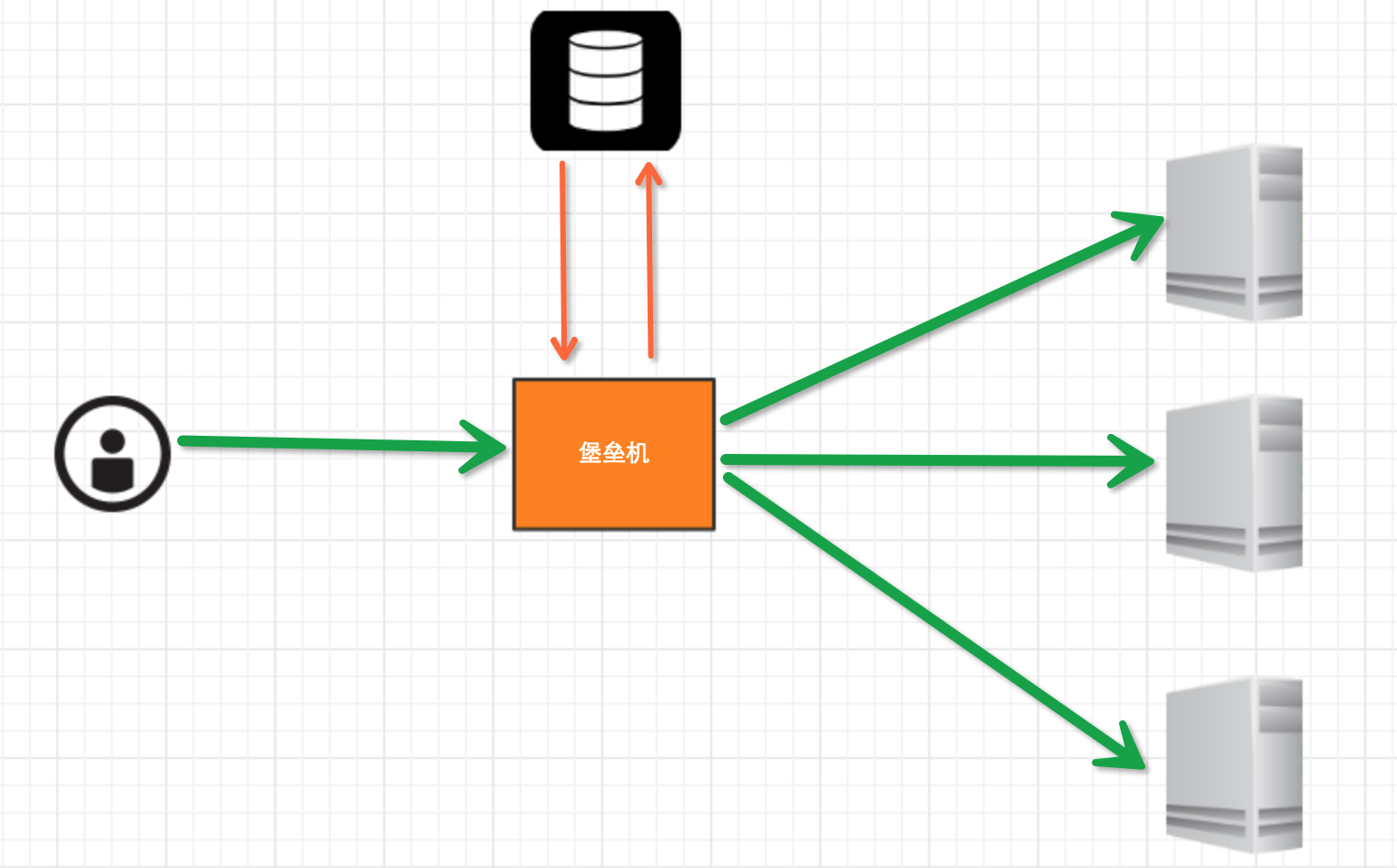基于python的堡垒机
一 堡垒机的架构
堡垒机的核心架构通常如下图所示:

二、堡垒机的一般执行流程
- 管理员为用户在服务器上创建账号(将公钥放置服务器,或者使用用户名密码)
- 用户登陆堡垒机,输入堡垒机用户名密码,显示当前用户可管理的服务器得列表
- 用户选择服务器,并自动登陆
- 执行操作并同时将用户操作记录
注:在linux中,通过配置用户的.brashrc文件,实现ssh登陆后自动执行脚本,如:/usr/bin/env python /home/jack/jump.py,完成业务操作后logout自动退出。
另外,想要正确可靠的发挥堡垒机的作用,只靠堡垒机本身是不够的, 还需要对用户进行安全上的限制,堡垒机部署后,要确保你的系统达到以下条件:
- 所有人包括运维、开发等任何需要访问业务系统的人员,只能通过堡垒机访问业务系统
- 回收所有对业务系统的访问权限,做到除了堡垒机管理人员,没有人知道业务系统任何机器的登录密码
- 网络上限制所有人员只能通过堡垒机的跳转才能访问业务系统
- 确保除了堡垒机管理员之外,所有其它人对堡垒机本身无任何操作权限,只有一个登录跳转功能
- 确保用户的操作纪录不能被用户自己以任何方式获取到并篡改,达到安全审计的作用。
三、python实现堡垒机
通过第三方模块paramiko,在python中可以很方便的实现堡垒机的基础功能,还可以通过django框架实现web管理和维护。
基本架构如下:

1. 简单的实现版本
该版本较简单,只能输入一行命令,回车,然后接收主机返回的信息,并打印。

#!/usr/bin/env python # -*- coding:utf-8 -*- import paramiko import sys import os import socket import select import getpass from paramiko.py3compat import u # python2.x中不需要这一行 default_username = getpass.getuser() username = input('Username [%s]: ' % default_username) if len(username) == 0: username = default_username hostname = input('Hostname: ') if len(hostname) == 0: print('*** Hostname required.') sys.exit(1) tran = paramiko.Transport((hostname, 22,)) tran.start_client() default_auth = "p" auth = input('Auth by (p)assword or (r)sa key[%s] ' % default_auth) if len(auth) == 0: auth = default_auth if auth == 'r': default_path = os.path.join(os.environ['HOME'], '.ssh', 'id_rsa') path = input('RSA key [%s]: ' % default_path) if len(path) == 0: path = default_path try: key = paramiko.RSAKey.from_private_key_file(path) except paramiko.PasswordRequiredException: password = getpass.getpass('RSA key password: ') key = paramiko.RSAKey.from_private_key_file(path, password) tran.auth_publickey(username, key) else: pw = getpass.getpass('Password for %s@%s: ' % (username, hostname)) tran.auth_password(username, pw) # 打开一个通道 chan = tran.open_session() # 获取一个终端 chan.get_pty() # 激活器 chan.invoke_shell() while True: # 监视用户输入和服务器返回数据 # sys.stdin 处理用户输入 # chan 是之前创建的通道,用于接收服务器返回信息 # select模块是IO多路复用模块,功能强大,无处不在,你值得学习和记忆! readable, writeable, error = select.select([chan, sys.stdin, ],[],[],1) if chan in readable: try: x = u(chan.recv(1024)) # python2.x中直接接收就可以,不要u if len(x) == 0: print('\r\n*** EOF\r\n') break sys.stdout.write(x) sys.stdout.flush() except socket.timeout: pass if sys.stdin in readable: inp = sys.stdin.readline() # 一行一行的读取用户在终端输入的命令 chan.sendall(inp) chan.close() tran.close()
2. 逐个字符发送的版本
上面是一行一行的命令执行方式,下面这个是一个按键一个按键的读取并发送方式。

# 从chan.invoke_shell()这一句往上省略,和上面的例子相同 import termios # 导入python的终端模块。注意,windows系统没有这个模块。 # 获取原tty属性,用于在退出时恢复原始状态 oldtty = termios.tcgetattr(sys.stdin) try: # 为tty设置新属性 # 默认当前tty设备属性: # 输入一行回车,执行 # CTRL+C 进程退出,遇到特殊字符,特殊处理。 # 这是为原始模式,不认识所有特殊符号 # 放置特殊字符应用在当前终端,如此设置,将所有的用户输入均发送到远程服务器 tty.setraw(sys.stdin.fileno()) chan.settimeout(0.0) while True: # 监视 用户输入 和 远程服务器返回数据(socket) # 阻塞,直到句柄可读 r, w, e = select.select([chan, sys.stdin], [], [], 1) if chan in r: try: x = u(chan.recv(1024)) if len(x) == 0: print('\r\n*** EOF\r\n') break sys.stdout.write(x) sys.stdout.flush() except socket.timeout: pass if sys.stdin in r: x = sys.stdin.read(1) # 用户每在键盘上敲击一个按键,就读取一下,并发送到主机 if len(x) == 0: break chan.send(x) finally: # 重新设置终端属性为原状 termios.tcsetattr(sys.stdin, termios.TCSADRAIN, oldtty) chan.close() tran.close()
3. 更高级的版本
在linux中有tab键补全功能,要实现它,需要按键读取的方式,接收主机返回的tab补齐信息,最后组合成完整的命令,并执行。另外由于windows操作系统没有termios模块,因此使用多线程的方式。

import paramiko import sys import os import socket import getpass from paramiko.py3compat import u # windows does not have termios... try: import termios import tty has_termios = True except ImportError: has_termios = False def interactive_shell(chan): if has_termios: posix_shell(chan) else: windows_shell(chan) def posix_shell(chan): import select oldtty = termios.tcgetattr(sys.stdin) try: tty.setraw(sys.stdin.fileno()) tty.setcbreak(sys.stdin.fileno()) chan.settimeout(0.0) log = open('handle.log', 'a+', encoding='utf-8') flag = False temp_list = [] while True: r, w, e = select.select([chan, sys.stdin], [], []) if chan in r: try: x = u(chan.recv(1024)) if len(x) == 0: sys.stdout.write('\r\n*** EOF\r\n') break if flag: if x.startswith('\r\n'): pass else: temp_list.append(x) flag = False sys.stdout.write(x) sys.stdout.flush() except socket.timeout: pass if sys.stdin in r: x = sys.stdin.read(1) import json if len(x) == 0: break if x == '\t': flag = True else: temp_list.append(x) if x == '\r': log.write(''.join(temp_list)) log.flush() temp_list.clear() chan.send(x) finally: termios.tcsetattr(sys.stdin, termios.TCSADRAIN, oldtty) def windows_shell(chan): import threading sys.stdout.write("Line-buffered terminal emulation. Press F6 or ^Z to send EOF.\r\n\r\n") def writeall(sock): while True: data = sock.recv(256) if not data: sys.stdout.write('\r\n*** EOF ***\r\n\r\n') sys.stdout.flush() break sys.stdout.write(data) sys.stdout.flush() writer = threading.Thread(target=writeall, args=(chan,)) writer.start() try: while True: d = sys.stdin.read(1) if not d: break chan.send(d) except EOFError: # user hit ^Z or F6 pass def run(): default_username = getpass.getuser() username = input('Username [%s]: ' % default_username) if len(username) == 0: username = default_username hostname = input('Hostname: ') if len(hostname) == 0: print('*** Hostname required.') sys.exit(1) tran = paramiko.Transport((hostname, 22,)) tran.start_client() default_auth = "p" auth = input('Auth by (p)assword or (r)sa key[%s] ' % default_auth) if len(auth) == 0: auth = default_auth if auth == 'r': default_path = os.path.join(os.environ['HOME'], '.ssh', 'id_rsa') path = input('RSA key [%s]: ' % default_path) if len(path) == 0: path = default_path try: key = paramiko.RSAKey.from_private_key_file(path) except paramiko.PasswordRequiredException: password = getpass.getpass('RSA key password: ') key = paramiko.RSAKey.from_private_key_file(path, password) tran.auth_publickey(username, key) else: pw = getpass.getpass('Password for %s@%s: ' % (username, hostname)) tran.auth_password(username, pw) # 打开一个通道 chan = tran.open_session() # 获取一个终端 chan.get_pty() # 激活器 chan.invoke_shell() interactive_shell(chan) chan.close() tran.close() if __name__ == '__main__': run()
三、通过堡垒机实现SCP


#!/usr/bin/env python import paramiko import os,sys,time hostname="192.168.1.111" # 远程主机 username="root" # 远程主机的用户名 password="SKJh935yft#" blip="192.168.1.1" # 堡垒机 bluser="root" #堡垒机用户名 blpasswd="SKJh935yft#" tmpdir="/tmp" # 客户机源文件路径、堡垒机临时路劲和远程主机目标文件路径 remotedir="/data" localpath="/home/nginx_access.tar.gz" tmppath=tmpdir+"/nginx_access.tar.gz" remotepath=remotedir+"/nginx_access_hd.tar.gz" port=22 passinfo='\'s password: ' # 这是密码信息 paramiko.util.log_to_file('syslogin.log') # paramiko自带的日志功能 t = paramiko.Transport((blip, port)) # 创建连接对象 t.connect(username=bluser, password=blpasswd) #建立连接 sftp =paramiko.SFTPClient.from_transport(t) # 创建SFTP连接 sftp.put(localpath, tmppath) # 利用put方法上传文件 sftp.close() # 关闭sftp连接 ssh=paramiko.SSHClient() ssh.set_missing_host_key_policy(paramiko.AutoAddPolicy()) ssh.connect(hostname=blip,username=bluser,password=blpasswd) #创建一个新的会话 channel=ssh.invoke_shell() channel.settimeout(10) buff = '' resp = '' # 利用linux原生的scp功能将堡垒机上的临时文件传送到远程主机上面 channel.send('scp '+tmppath+' '+username+'@'+hostname+':'+remotepath+'\n') while not buff.endswith(passinfo): try: resp = channel.recv(9999) except Exception,e: print 'Error info:%s connection time.' % (str(e)) channel.close() ssh.close() sys.exit() buff += resp if not buff.find('yes/no')==-1: channel.send('yes\n') buff='' channel.send(password+'\n') buff='' while not buff.endswith('# '): resp = channel.recv(9999) if not resp.find(passinfo)==-1: print 'Error info: Authentication failed.' channel.close() ssh.close() sys.exit() buff += resp print buff channel.close() ssh.close()





